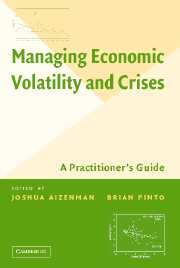Overview
Published online by Cambridge University Press: 25 July 2009
Summary
ABSTRACT: This overview introduces and summarizes the findings of a practical volume on managing volatility and crises. The interest in these topics stems from the growing recognition that nonlinearities tend to magnify the impact of economic volatility, leading to large output and economic growth costs, especially in poor countries. Good times tend not to offset the negative impact of bad times, which leads to permanent negative effects. Such asymmetry is reinforced by incomplete markets, sovereign risk, divisive politics, inefficient taxation, procyclical fiscal policy, and weak financial market institutions – factors that are more problematic in developing countries. The same phenomena that make it difficult to cope with volatility also drive crises. Hence, this volume also focuses on the prevention and management of crises. It is a user-friendly compilation of empirical and policy results aimed at development-policy practitioners and is divided into four modules: (i) the basics of volatility and its impact on growth and poverty; (ii) managing commodity price volatility, including agricultural commodities and oil; (iii) the financial sector, and its roles both as an absorber and amplifier of volatility and shocks; and (iv) the management and prevention of macroeconomic crises, including a cross-country study, case studies on Argentina and Russia, and lessons from the debt default episodes of the 1980s and 1990s. A Technical Appendix is also available.
- Type
- Chapter
- Information
- Managing Economic Volatility and CrisesA Practitioner's Guide, pp. 1 - 44Publisher: Cambridge University PressPrint publication year: 2005
References
- 9
- Cited by

